| 1. Upwelling systems and climate change | |
|---|---|
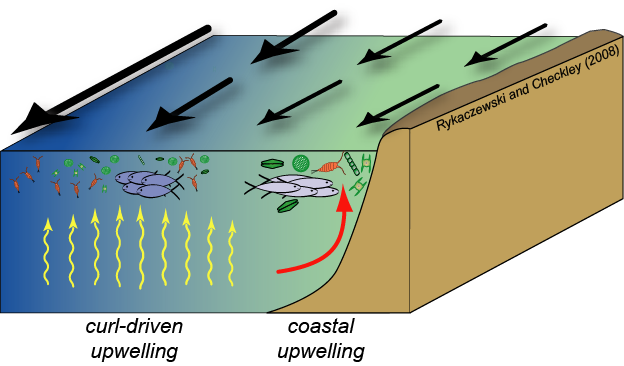
Upwelling areas are regions of the ocean in which alongshore winds force deep, nutrient-rich waters towards the sunlit ocean surface. The nutrients transported into the euphotic zone by upwelling support high levels of primary and secondary production. Valuable living marine resources (including vast populations of small pelagic fishes, marine mammals, and seabirds) are sensitive to changes in upwelling dynamics. The Rykaczewski Lab explores changes in the dynamics of upwelling ecosystems during historical periods, the response of these ecosystems to future change, and the implications of these changes to living marine resources and society. Two primary areas of research include a) changing characteristics of upwelling-favorable winds and b) variability in the properties of deep waters upwelled into the ecosystem. |
1a. Responses of upwelling-favorable winds to climate change |
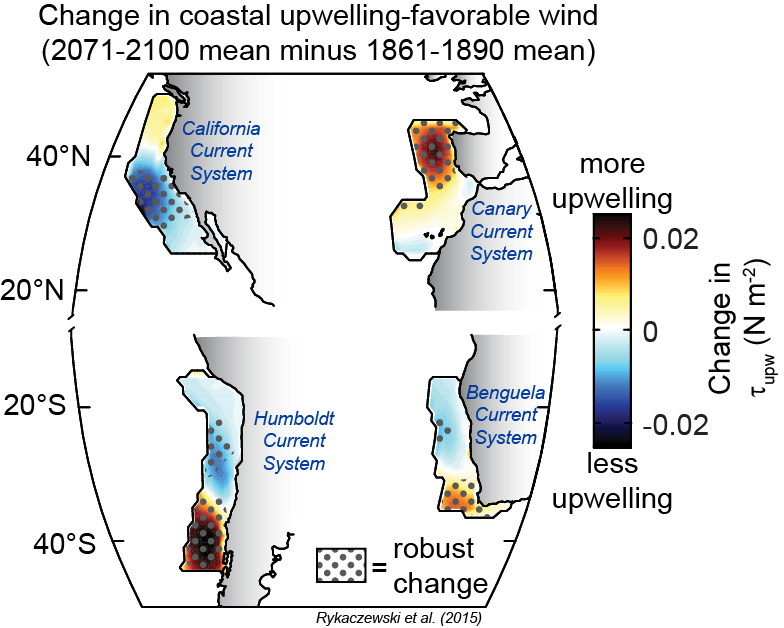
Upwelling-favorable winds are the result of steep, atmospheric pressure gradients which develop seasonally between major continental low- and oceanic high-pressure systems. These conditions are characteristic of mid-latitude eastern boundary currents (i.e., the California, Humboldt, Benguela, and Canary/Iberian marine ecosystems). Will coastal upwelling intensify in response to global warming? The answer is more complicated than "yes" or "no." The poleward displacement of atmospheric pressure systems associated with future climate change is likely to shift the distribution of mid-latitude, coastal upwelling winds (with increased coastal upwelling in poleward portions of the zones and decreased upwelling in equatorward portions of the zones), but these systems will continue to be subject to natural variability at interannual to multidecadal time scales. See Rykaczewski et al. (2015) in GRL and Brady et al. (2017) in GRL. |
1b. Variability in properties of source-waters supplied to upwelling systems |
|
In addition to changes in the magnitude, location, and seasonality of alongshore winds, variation in the biogeochemical properties of waters supplied to the upwelling regions may have a substantial impact on ecosystem function. In particular, changes in the nutrient concentrations, nutrient ratios, pH, and oxygen may influence community response to upwelling events. We are exploring the sensitivity of marine biogeochemical cycles to changes in ocean stratification and ventilation of North Pacific water masses. See Rykaczewski and Dunne (2010) in GRL. 
|
2. Size structure and trophic ecology of plankton and planktivorous fishes |
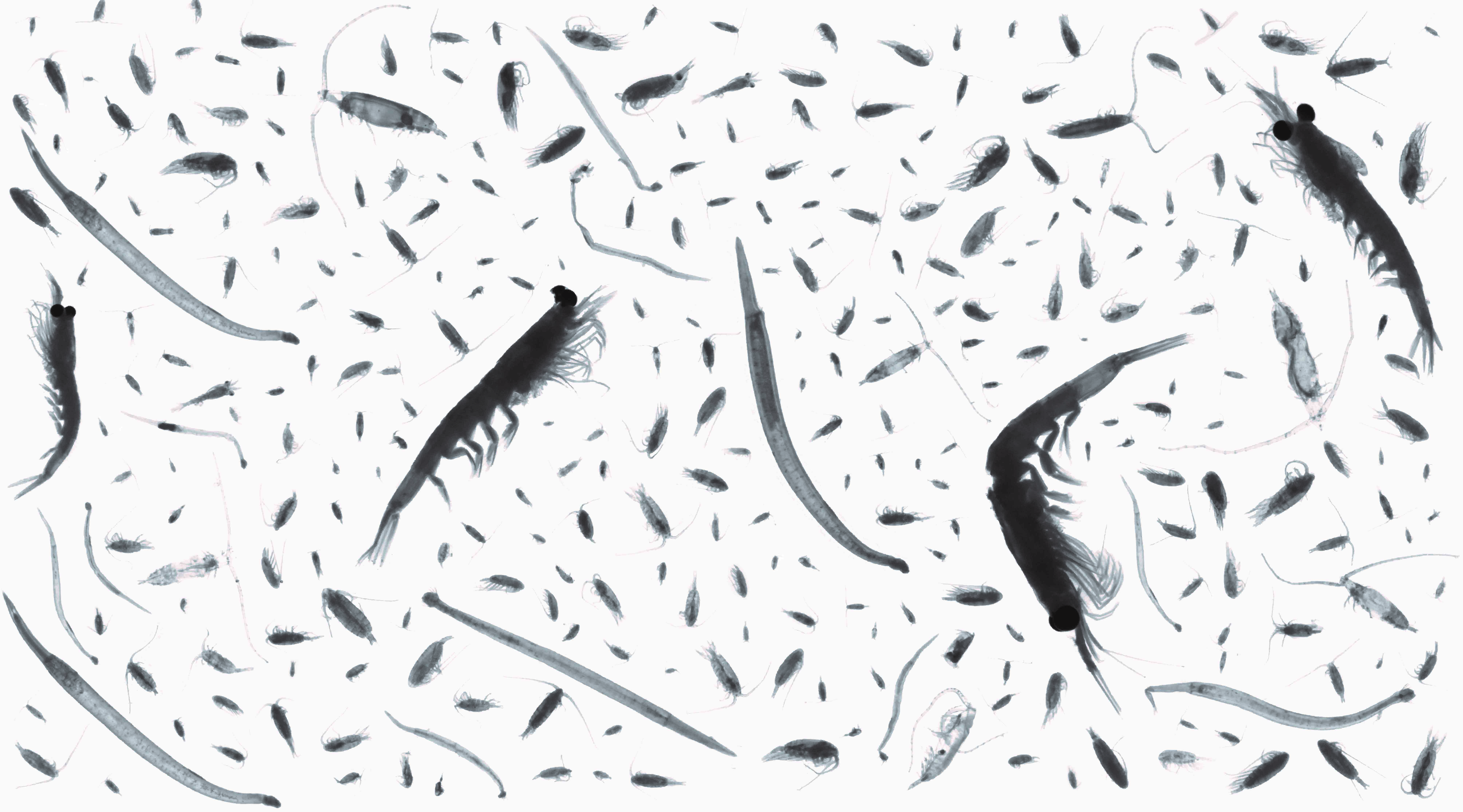
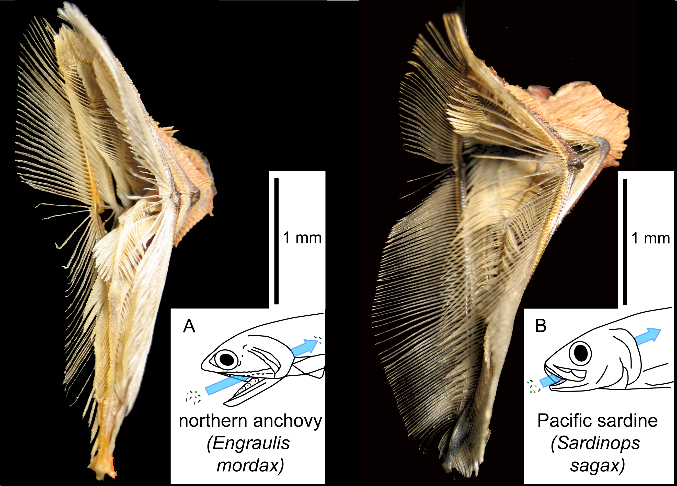
Nutrient concentrations and ratios affect the size and species composition of plankton communities. Mixing at the ocean surface chan alter the vertical distribution of plankton in the water column. These changes have the potential to affect the feeding ecology and bioenergetics of planktivorous fishes. Members of the lab are investigating the responses of zooplankton and phytoplankton composition to changes in nutrient supply and wind-driven mixing and are exploring the consequences of such changes on populations of clupeid fishes. See Rykaczewski (2019) in MEPS and Turley and Rykaczewski (2019) in CJFAS. |
3. Long-term trends in marine ecosystems |
|
The earth's climate system is sensitive to a number of factors which may alter the balance and distribution of energy across the globe. For example, volcanic eruptions alter the radiative balance of the atmosphere, redistributions of water masses and winds along the equator affect global temperatures during El Niño events, multi-decadal changes in the ventilation of the thermocline influence surface temperatures and primary production in the North Pacific, and variation in solar radiation changes the amount of energy the planet receives from the sun. Despite these sources of natural variability in the state of the climate system, human activities (e.g., changes in land use and the emission of greenhouse gases) have had a distinctive influence on the physical properties of the planet. Data from instrumental measurements, paleoclimate records, and computer models provide robust evidence that surface temperatures around the globe have increased, sea level has risen along the world's coastlines, and stratospheric ozone concentrations declined (and more recently rebounded). However, unequivocal evidence of the consequences of anthropogenic climate change on biological components of marine systems remains elusive. This lack of clear evidence does not imply that no changes have occurred. Rather, a plethora of plausible mechanisms relating biological trends to climate variability have been proposed. However, the long-term measurements required to attribute biological changes to anthropogenic climate change are often lacking. Research in the lab seeks to better quantify ecosystem consequences of anthropogenic climate change using historical observations and earth system models. Better understanding of the processes through which climate influences biology will inform observations and enhance the certainty of future detection-attribution studies. 
|
...In summary |
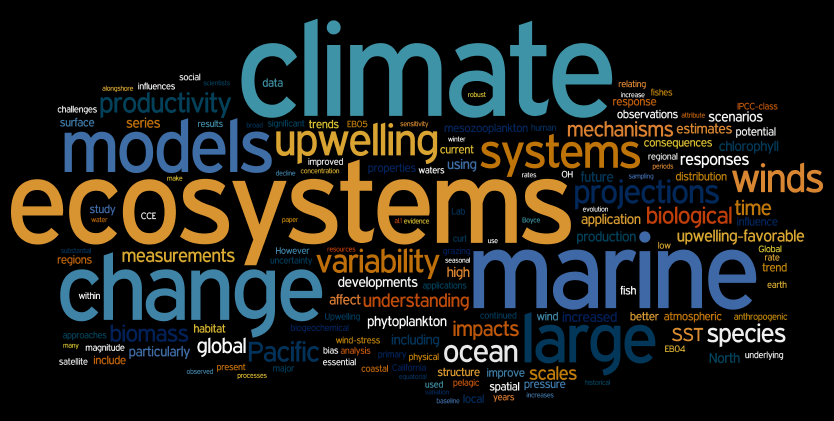
Generated by http://www.wordle.net/. |
|
 |

